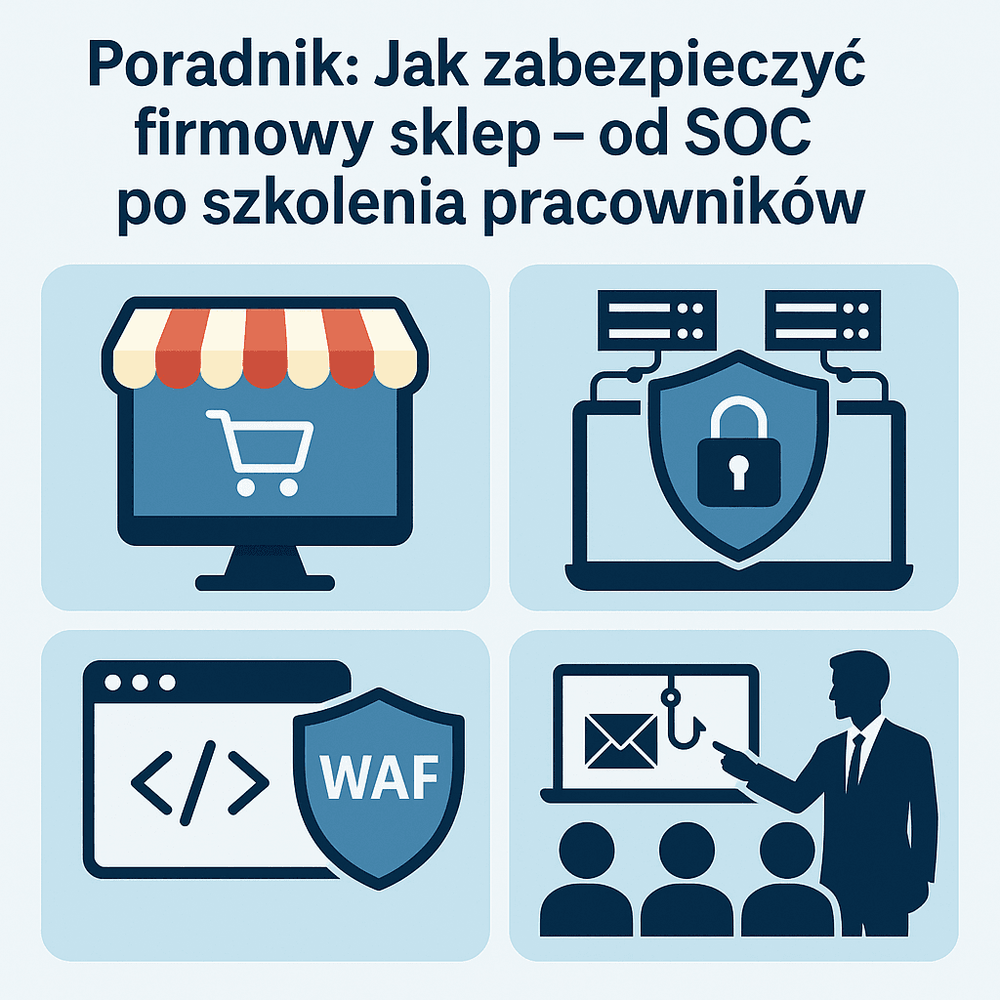Guide: How to Secure a Company Store – from SOC to Employee Training

source: own elaboration
E-commerce Security Is Key
With the growing popularity of online shopping, the number of threats is also on the rise. Online stores store valuable customer data (addresses, purchase history, card information) and have become attractive targets for cybercriminals. A lack of proper safeguards risks both losing customer trust and suffering serious financial losses. That is why the foundation must include implementing SSL, strong passwords, and regular updates of store software (engine, plugins, modules) – the absolute basics of security for any e-commerce platform.
The most common threats:
Above all, phishing and social engineering—fake emails or websites impersonating well-known brands to steal login and payment data. As highlighted by the CERT Orange 2024 Report, phishing remains the biggest threat, closely followed by DDoS attacks and malware. Ransomware, which encrypts data and blocks store operations, is also highly dangerous. According to Sophos, 69% of retail companies fell victim to such attacks in 2023. DDoS attacks are also fairly common—in May 2025, Polish networks recorded a record-breaking 1.3 Tbps attack that disrupted a major online retail operator. Finally, there are customer data leaks—for example, in December 2024, the hacker group Funksec published stolen data of over 200,000 customers of a Polish store (addresses, phone numbers, password hashes). These examples show that store security is not just about technology but about ensuring protection at every level of business operations.
The Role and Functions of SOC in Store Protection
A Security Operations Center (SOC) is a specialized unit (internal or external) that continuously monitors IT infrastructure and responds quickly to incidents. SOC analysts use advanced tools (including SIEM systems) to collect and analyze logs from various sources. This allows them to detect unusual behavior and threats in real time, and then take actions to mitigate their impact. SOC typically works with a CSIRT team, coordinating responses to serious attacks (isolating affected systems, cutting off traffic, restoring data). Another important SOC function is continuous monitoring of new attack techniques—specialists analyze cybercrime trends, emerging vulnerabilities, and reports of data leaks, allowing them to adjust security accordingly. Smaller companies that cannot maintain their own SOC can use external MDR (Managed Detection and Response) services, gaining access to security experts at a reasonable cost.
Key Security Tools
Effective store protection requires a layered security architecture. Recommended tools include:
Web Application Firewall (WAF): An application firewall operating at the web server level. It analyzes incoming traffic and blocks common attacks on web applications, such as SQL Injection and Cross-Site Scripting. WAF filters out much of the automated malicious traffic before it reaches the store’s code.
SIEM (Security Information and Event Management): A tool for collecting and correlating logs from multiple systems (servers, applications, network devices). SIEM detects patterns that indicate security incidents and generates alerts for the SOC team. With SIEM, specialists can identify attacks earlier—even from subtle indicators—and stop intruders at an early stage.
EDR (Endpoint Detection and Response): A solution for monitoring endpoint security (servers, workstations). EDR combines real-time scanning and behavioral analysis with responses to suspicious activity. It alerts the security team immediately about infection attempts or traffic that suggests compromise. Modern EDR platforms often use machine learning to detect even new types of attacks.
MFA (Multi-Factor Authentication): Authentication that combines something a user knows (password) with something they possess (e.g., an SMS code or mobile app token). With MFA, even if a password is stolen, account access is still hindered. MFA has become an industry standard in payments—for instance, PCI DSS 4.0 requires MFA “for all access” to systems processing cardholder data.
Vulnerability Scanners: Tools that automatically check systems and applications for known security flaws (CVE database). PCI DSS requires external scanning at least quarterly. Regular scans detect weaknesses before attackers do. Once a vulnerability is found, patches or protective measures must be applied quickly.
Other protective layers are also worth considering: antivirus/antimalware for servers, DLP (Data Loss Prevention) systems, VPN services for secure remote access, and anti-phishing solutions (filtering suspicious emails). The exact choice of tools depends on the store’s size and the type of data processed, but the elements listed above form the backbone of modern e-commerce protection.
Securing Infrastructure and Code
Protecting an online store also requires proper organization of its infrastructure and software development process. DevSecOps and CI/CD: automation of builds, testing, and deployments enables frequent updates and quick bug fixes. Already at the coding stage, it is worth enabling security scanners (static code analysis) and automated penetration tests, which minimize the introduction of vulnerabilities. As DevSecOps practice emphasizes, “automated code scanning, configuration management, and penetration testing minimize the risk of introducing vulnerabilities.” Implementing such practices means that potential errors are caught before changes are released to production.
Updates and backups: Outdated software is an entry point for attacks—therefore, the operating system, store platform, and all plugins must be regularly patched. Equally important is making regular backups of the store’s database and files. Cloud backups (with automated restores) allow the store to be quickly recovered after a failure or attack, minimizing downtime.
Network segmentation: Key assets (customer databases, payment systems) should be isolated in separate network segments. This way, an intruder who penetrates a less-protected area (e.g., the website) does not immediately gain access to the entire infrastructure.
Penetration tests and audits: Regular security audits (internal or external) and professional penetration tests help uncover non-obvious weaknesses. They are recommended at least once a year and after every major system change. Test results make it possible to plan fixes before attackers exploit them.
Security Policies and Employee Training
Often the weakest link is the human factor. Education and procedures: Clear security policies (e.g., password creation rules, procedures for responding to suspicious emails) should be developed and staff should undergo regular training. According to experts, “one of the most common causes of incidents is human error.” Cybercriminals are becoming increasingly adept at social engineering, so employees need to be trained to recognize phishing and other traps. As cert.pl points out, staff training is crucial because attackers may send fake emails specifically targeting store employees.
Customer awareness: It is also worth informing customers about safe practices—for example, reminding them to use trusted payment channels and not reuse passwords from other services. Transparent communication about security measures (e.g., WAF, data encryption) builds trust.
Incident response team: Every company should designate a team or individual responsible for security (CISO or security administrator). They maintain policies, organize training, and coordinate actions after incidents are detected. Combined with a SOC and implemented incident response procedures (IRP), this creates a cohesive company defense mechanism.
xamples of Incidents and Lessons Learned
Major data breaches: In 2023, global retail networks reported high-profile attacks. For example, the British clothing chain JD Sports revealed that hackers had broken into its order servers and stolen the personal data of about 10 million customers (name, address, email, phone numbers, and the last digits of payment cards). The consequences included widespread financial fraud and enormous costs of customer notifications and security audits. Lesson learned: even well-known brands may lack sufficient safeguards, so storing only minimal data and applying strong encryption is essential.
Extortion attacks: The Polish store sklepbaterie.pl fell victim to hackers from the Funksec group (December 2024). Cybercriminals took over a database of 218,000 customers (emails, phone numbers, encrypted passwords) and demanded a ransom of USD 10 million, threatening to publish the full data. Ultimately, they leaked only part of the records (32 MB), but this was enough to reveal weak hashing (some passwords had been protected with the now outdated MD5 algorithm). Lesson learned: systems safeguarding customer data should be regularly reviewed for cryptographic algorithms used, as well as the effectiveness of backups and disaster recovery plans (DRP).
Other examples: In the U.S., large retail chains (e.g., Ace Hardware and Staples) experienced ransomware attacks that paralyzed warehouses and online services. After the attack, hackers often contacted employees trying to extract more data (e.g., repeated phishing against franchise owners). This shows that lessons learned after an attack must be comprehensive: it is not enough to restore systems—post-incident training and verification of response procedures are also necessary.
Recommendations and Best Implementation Practices
In summary, e-commerce companies should adopt the following practices:
Incident Response Plan (IRP): Developing clear procedures (who responds and how) is the first line of defense. When an attack occurs, rapid identification and isolation of the threat can save the business. Every organization should have a clearly defined “emergency plan” covering response steps and internal/external communication.
Layered protection: Security should be built across multiple levels—physical (servers in a secure data center), network (firewalls, segmentation), application (WAF), and data (encryption). Multi-layered defenses make it harder for cybercriminals to reach critical systems even if one layer is breached.
Investment in technology and training: Modern AI-based tools (e.g., for threat analysis) can help predict attacks. Equally important, however, is raising employee security awareness. Trained staff who are regularly reminded of threats form the first line of defense against phishing and human error.
Regular audits and penetration tests: Conducting annual or semi-annual tests helps detect vulnerabilities before cybercriminals do. Continuous vulnerability scanning and penetration testing provide a better understanding of risks and allow them to be eliminated on an ongoing basis.
These measures—although they require financial and organizational investment—significantly increase a store’s resilience to attacks. The key, however, is focusing on the fundamentals and continuously updating the strategy. The cyberthreat landscape evolves quickly, so an online store must also constantly improve its safeguards. Only then can an e-business effectively protect its customers and its own reputation.

